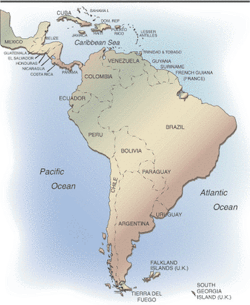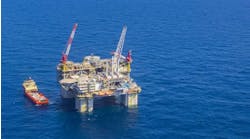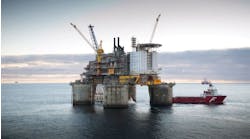Judy Maksoud
International Editor
Trinidad and Tobago, the most attractive new play in Latin America, is receiving the most new investment money in the region. Brazil is still receiving the most development money, particularly for its giant deepwater fields. And traditionally protective Petroleos Mexicanos (Pemex) and Petróleos de Venezuela, SA (Pdvsa) continue to purport to want foreign investors, albeit on their own very demanding terms. Border disputes and political instability are making investment in some areas decidedly unattractive. The more things change in Latin America, the more they remain the same in some respects.
The newest frontier
The Angostura oil field and additional oil finds in block 2c off Trinidad and Tobago have encouraged exploration along the same trend. There seems to be consensus among operators that there is a lot more oil in the region. A number of very large prospects identified in nearby fields will keep exploration activity high.
While oil exploration warms up, the country has shot up the charts as one of the world's hottest gas plays. Trinidad is attracting a lot of exploration dollars, with successful developments leading to more investment. Major players from around the world are betting on a high rate of return off Trinidad.
Pdvsa announced plans to spend $375 million over the next three years on a natural gas exploration project. Pdvsa spent $32 million in 2001 and has allocated another $158 million in 2002.
In early July, the government of Trinidad and Tobago signed a memorandum of understanding with 12 international exploration companies to carry out ultra-deepwater seismic exploration. Surveys will cover previously unsurveyed areas from 5,610 to 9,900 ft water depths off the country's east coast.
A month before the ultra-deepwater seismic survey was announced, WesternGeco opened a new seismic data processing center in Port of Spain. The potential for increasing the proven oil and gas reserves in Trinidad is considered to be significant. WesternGeco has positioned itself to facilitate exploration and development efforts by providing in-country seismic data acquisition, processing, and analysis.
Low bids, continued development
The latest news on Brazil is the relatively poor showing in the country's fourth bidding round, held in June. This year's licensing resulted in less than half of the blocks - 21 of 59 - being awarded. Predictably, Petróleo Brasileiro SA (Petrobras) was the biggest bidder, but even Petrobras bid conservatively, avoiding the riskiest deepwater blocks. With a series of deepwater exploration wells coming up dry, few operators are interested in making significant drilling investments at present. This in part explains why only two of the six Campos basin blocks were awarded.
With less interest in the bidding this year, the Agência Nacional do Petróleo is considering changing the terms for the fifth round next year. One option being weighed is reducing the size of the blocks in hopes of reducing the required investment, which would in turn draw a broader base of companies.
The fact that exploration activity is slowing, however, should not be taken to imply that offshore activity is slow. Brazil is still South America's second largest oil producer, with 9.67 Bboe in known reserves. Development activity is high and will continue to be so over the next few years. According to Douglas-Westwood Ltd.'s 2002 "World Subsea Report," in the 2002-2006 period, Brazil will see the greatest percentage of subsea capital expenditure spending in the next four years. The deepwater Campos, Santos, and Espirito Santo regions will continue to produce. Though no new elephants have been found, there is still a lot of work going on in the Brazilian offshore.
As domestic oil consumption grows, foreign operators and foreign money will have a bigger presence in Brazilian E&P. Not surprisingly, Petrobras will continue to have the starring role. When not acting as operator, Petrobras will hold interest in the majority of offshore operations. Three years ago, there was one oil company operating off Brazil. Today, there are 35, and the number continues to grow. Although change has not come about quickly, the tide is turning for outside investment.
With the untapped potential of Brazil's offshore, all it will take is another big find outside Campos to bring more foreign companies in with a vengeance.
Mexico resists change
Early in 2002, Pemex announced an offshore exploration effort that would cover coastal areas to a depth of 2,600 ft. In July, Pemex began making preparations to move into deepwater, according to the Mexican Petroleum Institute (IMP), for which Pemex is the main client. At that time, work was underway to establish the technology necessary to explore in 6,500-ft water depth, far beyond the 295-ft water depth of the deepest well to date. Pemex is also planning deepwater seismic surveys in the Gulf of Mexico over the next four years.
Pemex has invested more than $4 billion/yr on exploration and production. With all of the current plans in place, the cost could double next year.
Mexico's difficulty in drilling at greater water depths is a result of exclusion. Pemex is the only company permitted to exploit the country's hydrocarbon resources. Though some foreign companies have drilling contracts and are providing technical services for Pemex, exploration and production are closed to foreign oil companies.
If President Vicente Fox makes more headway in reforming the petroleum industry, there could be more opportunities for more foreign E&P involvement off Mexico. However, progress along these lines has been slow. Despite voting Fox into office on a platform of change, there is a strong resistance to the forward-looking changes Fox is trying to implement.
If things end up as predicted, Pemex will continue to be the only producer of oil for the foreseeable future. In short, privatization is not in the cards any time soon.
Nagging problems
Venezuela's enormous resource base guarantees the country's place in providing world supplies of oil and gas for years to come. Pdvsa has 76 Bbbl of proven crude reserves, and gas reserves total 147 tcf. Venezuela has prospects of discovering an additional 23 Bbbl of condensates and light and medium crudes and 94 tcf of gas.
Pdvsa has published a three-pronged strategy for growth through 2009: Exploration effort using its own resources, Pdvsa-directed exploration in mature fields through operating contracts, and third-party risk exploration in new areas.
In fulfilling the first segment of this plan, Pdvsa has committed to recording 8,400 km of 2D seismic and 11,000 sq km of 3D. The company also plans to drill 230 wells during this period. The goal of this $2.5-billion effort is to incorporate estimated proven and probable reserves totaling 9 Bbbl of condensates and light and medium crude oils and 35 tcf in associated gas.
Pdvsa also plans to gather additional seismic surveys over known producing areas with private foreign companies over the next seven years. The goal is to identify 120 MMbbl of oil and 250 bcf of gas that can be recovered in regions that have proven prolific.
The third segment of the growth strategy focuses on new areas. Pdvsa intends to share risk by entering into production sharing agreements with private consortia.
Though these are fine objectives, the devil is in the details. Upheaval within Pdvsa resulted in extended strikes and enormous upset to oil and gas exports. Even with a new management group in place, things have not been progressing smoothly.
Pdvsa has openly announced its need for new technology to produce its more difficult fields, yet the company has done little to bring in investors. A new law announced in January increased state control over the industry and imposed the highest royalty rate in the world. Even though the need for technology is reaching a critical level, Pdvsa has failed to put its money where its mouth is. The plea for investors continues as the investment terms grow progressively less palatable.
The strikes at Pdvsa earlier this year have brought about a government financial crisis. Reports this summer indicate that Venezuela has increased oil output 400,000 b/d above its OPEC quota. Pdvsa has denied this claim in the face of a poor track record for keeping to OPEC's numbers. Since no real numbers are available to support or refute this charge, the report's credibility is difficult to verify. A critical fact to keep in mind is that Venezuela depends on oil for almost half of the government's income.
Border belligerence
Guyana and Suriname are still struggling to find a way to exploit their offshore resources. Earlier this year, it seemed that the years of rivalry and a near coming to blows over a boundary dispute were soon to be part of the past. (In June 2000, a Surinamese naval vessel ordered CGX Energy's jackup CE Thornton working on a Guyanese contract out of the disputed offshore area north of the Corentyne River.)
Unable to carve up their offshore to mutual agreement, the two countries began laying the groundwork to form a joint venture that would allow them to exploit the estimated 15 Bbbl of oil reserves in the Guyana-Suriname basin. Thus far, they have not made notable progress. There will be little activity in the Guyana-Suriname basin until the two countries figure out how to move forward together.
Nicaragua recently announced its plans to get into the oil and gas business. The Institute of Energy put a number of offshore blocks up for bid, imposing an Oct. 10, 2002, deadline for filing qualification applications. Successful exploration will lead to 20-year production concessions.
Interest in Nicaragua's offshore was sparked by results from a Fugro-Geoteam survey gathered last year. Four oil consortia began exploration activities this summer after President Enrique Bolanos signed legislation allowing exploration off the Miskitos and Perlas island chains in the Caribbean.
Unfortunately, after initially agreeing that the proposed maritime boundaries were fine, neighboring Honduras disputed Nicaragua's claim to the area. Now, the International Court of Justice in The Hague has been charged with resolving the dispute over a pie-shaped section off the northwest coast of Nicaragua.
Down and out in Argentina
Early in 2Q 2002, TotalFinaElf put development of its Carina and Aries natural gas project off the southern coast of Argentina on hold for at least a year. The company announced that drilling would be suspended onshore and that only work already in progress offshore would be completed. The $400-million development was scheduled to come onstream in the second half of 2003, with gas production expected to reach 12 MMcm/d.
Petrobras is one of the few countries actively investing in Argentina. The company purchased Perez Companc in 3Q 2002, followed by a $90 million buyout of Devon Energy's Argentine assets.
The biggest hurdle for would-be investors is Argentina's financial situation. In early August, the country was anxiously awaiting word on assistance from the International Monetary Fund, aid that was not necessarily forthcoming. Argentina was hoping for US and IMF aid to help alleviate the financial crisis. With unemployment at 20% and inflation hovering at 35% for the year, Argentina is in dire straits. And animosity toward the US, which is being blamed for exacerbating the problem, is not likely to encourage American investors any time soon.
Out of the running
US policy continues to keep American companies out of Cuba. Offshore acreage in the country's exclusive economic zone includes areas in the western Straits of Florida, the southeastern Gulf of Mexico and the Yucatan margin, and the northwestern Caribbean Sea. The area encompasses 59 blocks averaging 2,000 sq km each.
Compagnie Générale de Géophysique recently released seismic analysis of Cuba's deepwater region and has identified two sizable basins, indicating significant hydrocarbon exploration potential. According to CGG, the offshore anticlines could contain mature oil and gas, constituting an important petroleum province.
Colombia has been taking desperate measures to keep its foreign investors. Late in July, President Andrés Pastrana signed into law a new royalty system that had been approved by the Colombian Congress the previous month. The law will tremendously reduce the royalties oil and gas companies operating in the country will have to pay the state.
The new law imposes royalties of 8-20% for fields producing less than 125,000 b/d and 20-25% on fields producing 400,000-600,000 b/d.
There are six oceanic basins along Colombia's offshore, covering 196,000 sq km. Potential for oil discovery in these areas is over 9 Bbbl. With 2.6 Bbl of proven oil reserves, Colombia should be able to turn its plentiful reserves into capital. However, political instability is a chronic and seemingly unsolvable problem that continues to repel would-be investors.
Getting back in the game
In early April, a delegation from the Falk-land Islands began making overtures to oil companies in hopes of rekindling interest in the islands' prospectivity. Finds were made offshore the Falklands in 1998, but they were not proven commercial. Seismic shot at that time indicated 60 Bbbl in reserves offshore. Now, the country wants to get back in the E&P game.
According to Phyl Rendell, director of mineral resources in the Falklands, the situation in the Middle East and the increased price of oil combine to make the islands an attractive alternative for oil companies seeking new sources of oil. The hope is that exploration could resume off the Falklands by 2004.
Frontier acreage has already been awarded to the newly formed Falkland Islands Hydro-carbon Consortium. The joint venture, comprising Global Petroleum and Hardman Resources, now holds 10 adjoining exploration licenses covering 57,700 sq km southeast of the islands in water depths to 6,562 ft. Delineation of the region's prospectivity got underway in August with a seismic survey.
In mid-January, state-owned Petroecuador announced that preparations were being made to announce the country's ninth international oil and gas exploration licensing round. Now, Petroecuador has made firm plans for its ninth bidding round, which will take place in October. Originally, the bidding was to include four offshore blocks. Accor-ding to an announcement in July, the current acreage up for bid covers 13 blocks at 200,000 hectares each. Only two of the blocks are offshore, in the Gulf of Guayaquil.
Ecuador is dependent on foreign investment to exploit its hydrocarbon resources. The country has made efforts to draw those investors by allowing companies to work on foreign currency and to use existing infrastructure to move product to market.





